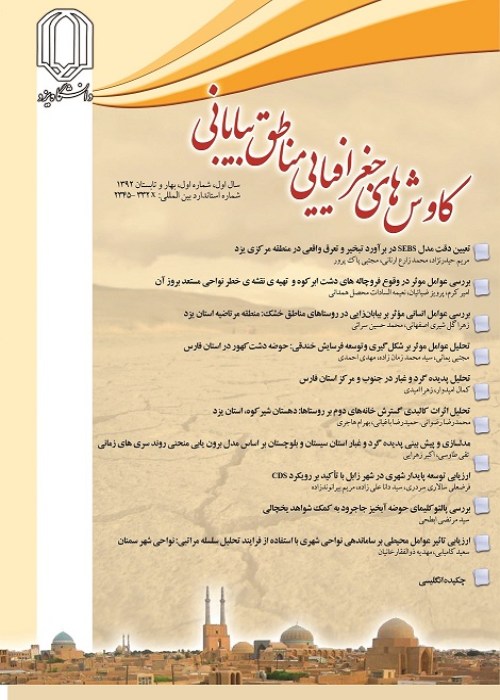Study of the effect of sunspots on seasonal and annual precipitation through wavelet analysis: A case study of the stations in Isfahan and Kashan
The sun is the main source of Earth energy and its climate changes. Changes in the amount of energy emitted from the sun or in its surface temperature can cause fluctuations in the atmosphere. Solar spots are among the factors that can affect the climatic conditins of the Earth periodically and ultimately lead to climate changes. The wavelet transform (WT) has been a major development in the field of data analysis since the 1980s. It is an effective means of processing time-series data, especially those with nonstationary characteristics. Iran has been experiencing high climatic variations during the past decades.Wavelet analysis can be a powerful tool to analyze the processes that are nonstationary in nature and occur over finite spatiotemporal domains. In particular, it is used to study oscillatory behavior and reveal the periodicities present in signals. To obtain the possible correlations among the periodic behaviors represented in environmental datasets, wavelet analyses have to be performed. A wavelet is a wave-like oscillatory function which is localized in a time and frequency space and must have a mean of zero. The output is a graphical representation of the 95% confidence level contour, which shows the correlation between two time series, as a function of the signal period and its time evolution
Wavelets are flexible functions that are resolved in the time and frequency domains and, thus, ideal to quantify the changes in the contribution of each period (or frequency) over time to the overall variance (or power) of a signal (e.g., a time series). Because wavelets can be scaled (i.e., contracted or dilated), they can efficiently accommodate both high and low-frequency structures in nonstationary signals, whose statistical characteristics vary over time. In this study, the Morlet wavelet was used, and the spectral analysis of precipitation time series was done through using the wavelet theory with the aim of identifying the effect of sunspots on the spectral behavior of precipitation. The precipitation data as well as the data on the sunspots for a period of 50 year (1961-2010) were used at two synoptic stations of Isfahan and Kashan. To this end, the researcher benefited from statistical analysis and wavelet analysis using the MATLAB software. Sunspots are the most important indicators of the variability in solar radiation; in the majority of studies, the relative number of sunspots is mainly used to analyze the sunspot changes.
Many studies have analysed the variability in precipitation, since climate change has become a major global issue. We investigated the trends of precipitation in two synoptic stations of Isfahan and Kashan and explored the changes in local water resources to improve our understanding of the impacts of climate change on water resources in the area sunspots in different years. Also, the correlation coefficients of these fluctuations at the mentioned stations were calculated. Based on the wavelet analysis, it was obvious that during all the months of the year sunspots activity left behind an 11-year-old cycle. Of course, in different months, the extremes of activities and fluctuations were found to be different. The plotted wavelets for different months of the year were evaluated. It was revealed that, during the statistical period of 60 years, there have been four cycles in the sunspot activity with a different degree of intensity in each cycle. According to the results, there was no significant relationship between precipitation and the activity of solar spots. Based on wavelet analysis, there was a poor negative correlation between them. Considering the analysis of a 50-year period, four 11-year cycles were observed in the sunspot activity.
Sunspots are the most important indicators of variability in solar radiation. In the majority of studies, the relative number of sunspots is mainly used to analyze the sunspot changes. The application of wavelet transform and regression analysis helps to interpret the periodic cycles, trends and non-stationarities on different timescales in the climate records examined. The present study was conducted based on the annual, seasonal, and monthly averages of the sunspots during a statistical period of 50 years derived from the American Geophysical Union. The aim was to investigate the connection among the 11-year sunspot activity cycles and precipitation patterns in two synoptic stations of Isfahan and Kashan from 1961 to 2010. It was observed that the peak activity was in the second and the third cycles, and the least one was in the first and the fourth cycles. Additionally, the range of rainfall cycles (7-12 years) was higher in the fall than in the other seasons at the studied stations. The findings of this study can be beneficial for policymakers to consider future potential droughts and wet years based on sunspot activities so that water resources can be more properly managed.
- حق عضویت دریافتی صرف حمایت از نشریات عضو و نگهداری، تکمیل و توسعه مگیران میشود.
- پرداخت حق اشتراک و دانلود مقالات اجازه بازنشر آن در سایر رسانههای چاپی و دیجیتال را به کاربر نمیدهد.



